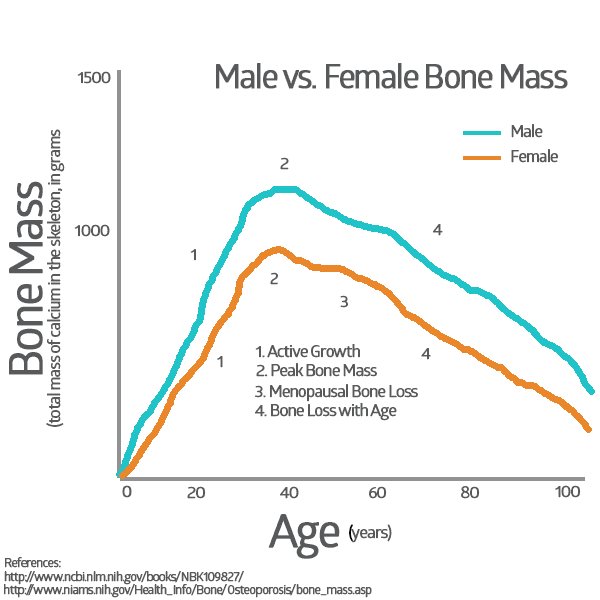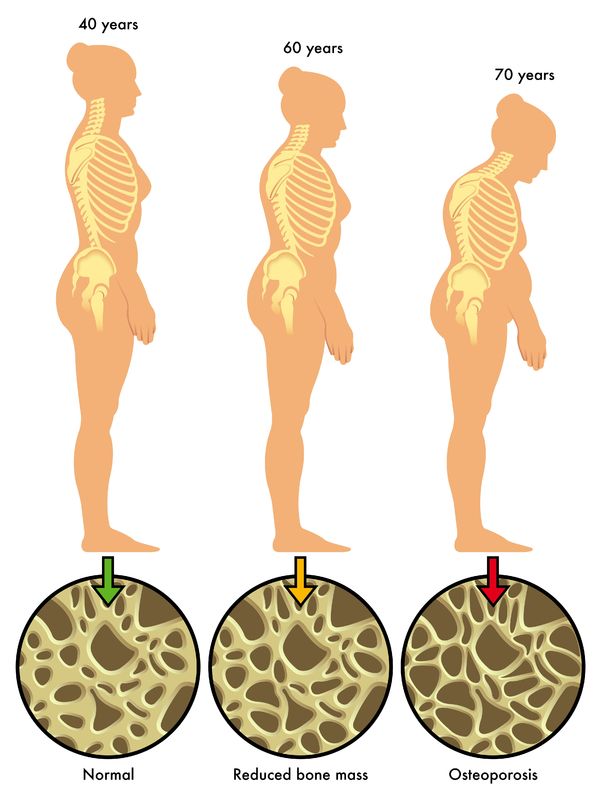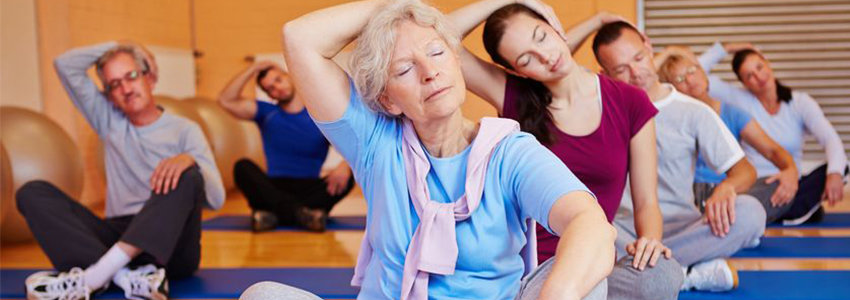Osteoporosis in Women
According to the National Osteoporosis Foundation, of the estimated 10 million Americans with osteoporosis, about eight million or 80% are women!
https://www.youtube.com/watch?v=RWZoMFAHfTI
Why Are Women More Likely to Develop Osteoporosis?
Well for starters, women start out with less bone density than men and typically have smaller, thinner bones.
As mentioned earlier, estrogen plays a vital role in women’s bone health. This applies to men as well. However due to higher bone density and without the drastic decline in estrogen during menopause, men have an advantage over osteoporosis that unfortunately, we as women do not.
This does not mean our male counterparts are off the hook entirely. It just means that men are more likely to be diagnosed with osteoporosis later in life. Typically around 65 to 70 years of age is when both men and women are losing bone density at the same rate. It’s important to note that not only are you losing bone density during this age, you’re losing muscle mass. Hence why weight bearing exercise such as walking, jogging and hiking are so important to your bone health.
Now that we know that menopause and smaller, thinner bones contribute to osteoporosis, what are the other contributing factors? Are there any? The answer unfortunately is, yes.

Causes/Symptoms of Osteoporosis in Women
As mentioned before, women are twice as likely to get osteoporosis compared to men so it’s even more important that women are proactive in preventing it. Becoming aware of the causes and symptoms related to the disease is a great place to start. Let’s start with the causes:
- Smoking/Excessive Alcohol Consumption: It’s a given that smoking and excessive drinking are no good for our health and our bone health is no exception to this rule.
- Medications: Such as steroids (cortisone and prednisone), chemotherapy drugs, Heparin (blood thinner), phenytoin and phenobarbital (used to treat epilepsy) and proton pump inhibitors (PPIs) used to treat peptic ulcers, heartburn and acid reflux are just some of the medications that can contribute to bone loss. As a precaution, check with your doctor to see if any of the medications you are taking is contributing to bone loss.(5)
- Underlying Medical Conditions: Rheumatoid Arthritis (RA), cancer (in particular, breast cancer and prostate cancer), missed periods, eating disorders, gastrointestinal disorders such as Crohn’s disease, celiac disease and ulcerative colitis which makes it difficult to absorb nutrients including calcium and vitamin D.(5)
- Family History: If your mother and grandmother have suffered from osteoporosis, as a woman, you are at an even higher risk of developing the same as it tends to run in families.
- Poor Diet/Lack of Exercise: We hear this all the time, “eat right and exercise.” Yet poor eating habits and lack of exercise remains an epidemic in North America. As mentioned before, weight bearing exercise plays a key role in maintaining healthy bones. As for diet, avoid processed sugar (put down the soda and opt for a nice glass of cold milk!) and foods with high sodium content. The good news? Contrary to popular belief, you can go ahead and have that cup of coffee! Find out why coffee is not so bad for your bones like we once thought. Read here.
When it comes to osteoporosis – we know that symptoms can remain dormant before realizing something is wrong. However it’s not an impossible feat to pick up on some of the early warning signs in order to prevent more serious symptoms of the disease from developing.
Early Signs of Osteoporosis:
- Osteopenia (the precursor to osteoporosis)
- Receding gums/Loose teeth – This may be a sign of bone loss in the jaw(7)
- High levels of serum calcium on a blood test. More calcium in your bloodstream can mean less calcium is being retained where it should be – in your bones(7)
- Vitamin D deficiency
- Weak/Brittle nails
- Foot and Leg Cramps – This can be associated with low potassium blood levels. It may also indicate low calcium and magnesium blood levels.
Typical Signs of Osteoporosis in Women:
- Bone fracture. Especially if pertaining to the hip, spine, and/ or wrist. More specifically, if the fracture has happened suddenly or with little effort, this is a telltale sign.(1)
- Loss of height
- Back pain/Bone pain
- A “stooping” or “hunched” posture – which may point to a compressed spine or spinal fracture.(2)

How Is Osteoporosis Treated In Women?
Fear not! There are treatments available for osteoporosis in women, the most common treatments are:
- Lifestyle change: If you already maintain a healthy lifestyle, great job! Keep it up! If not, it’s time to implement some changes. I say again, weight bearing exercise! If you smoke, stop! You can also make simple changes to your diet that can make your bones that much happier. Every little bit counts!(6)
- Strontium citrate: Strontium citrate is a trace mineral found in the soil and chemically similar to calcium. We ingest small amounts typically from root vegetables. In larger doses, strontium citrate has been shown to slow down our bone loss cells and increase our bone building cells (osteoblasts).(4)
- A high quality calcium supplement: Such as AlgaeCal Plus. It not only provides you with a high quality plant-based calcium, but also bone supporting minerals, like these.
- Anti-resorptive drugs: A class of drugs used to stop our osteoclasts (bone loss cells) from resorption. Most doctors will recommend this approach, but it comes with dangerous side effects, including osteonecrosis of the jaw!
As always, before starting any treatment, consult with your doctor and do your homework. Knowledge is power! Remember, no matter your age, or gender, it’s never too late to start taking care of your bones!
Have any additional questions about osteoporosis in women? Comment below!
Sources:
- nof.org/articles/235
- everydayhealth.com/osteoporosis/osteoporosis-and-gender.aspx
- healthywomen.org/condition/osteoporosis
- webmd.com/osteoporosis/guide/strontium-treatment-osteoporosis
- mayoclinic.org/diseases-conditions/osteoporosis/in-depth/osteoporosis-treatment/art-20046869
- osteoporosisprotocols.com/osteoporosis-treatment/
- betterbones.com/bonehealth/earlysymptoms-osteoporosis-osteopenia.aspx
- en.wikipedia.org/wiki/Osteoporosis





Betty
March 19, 2016 , 6:01 amOsteo Strong was recommended to me by my doctor (who, by the way, goes to Osteo Strong himself!) as a method to build up my bone density. You might want to check this out online. I haven’t been going long enough yet myself to offer any personal results.